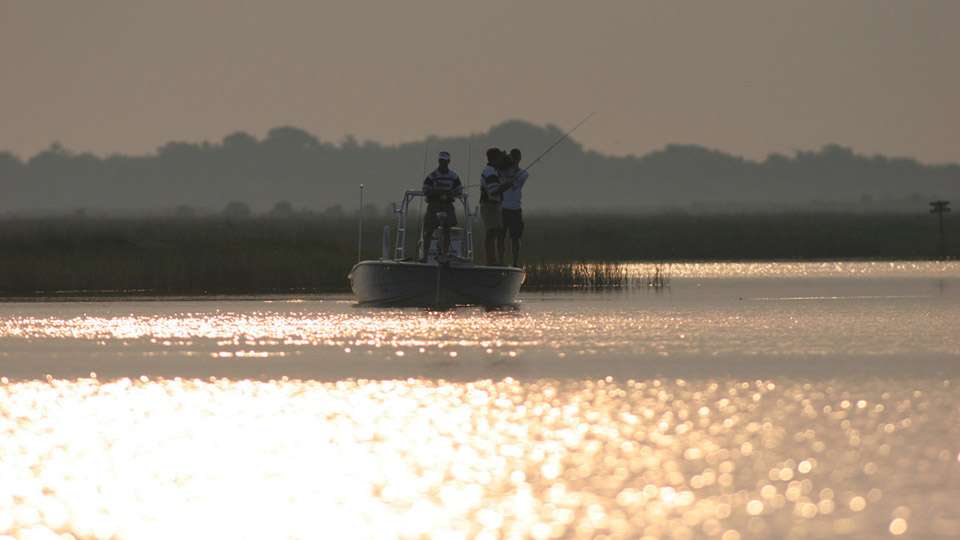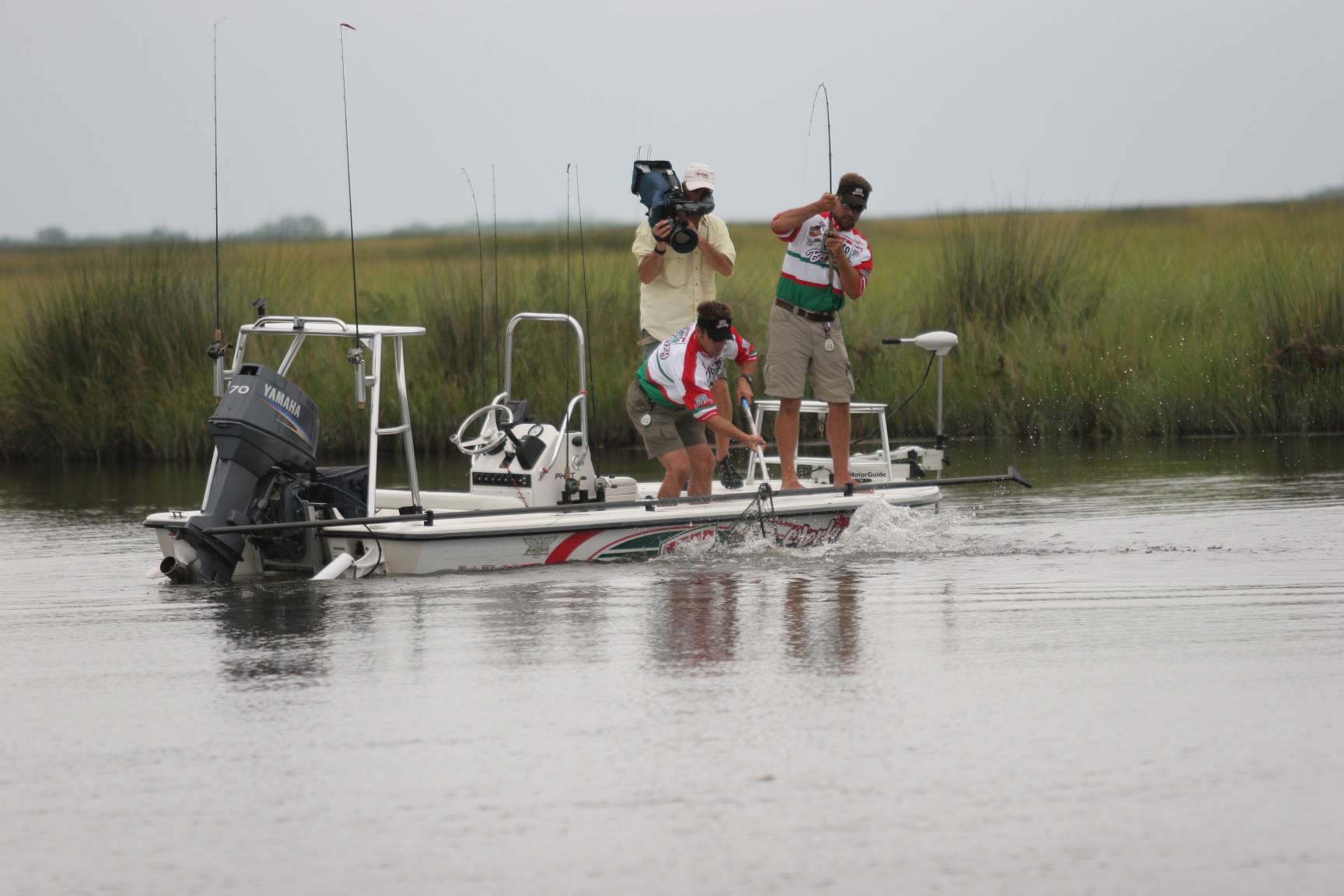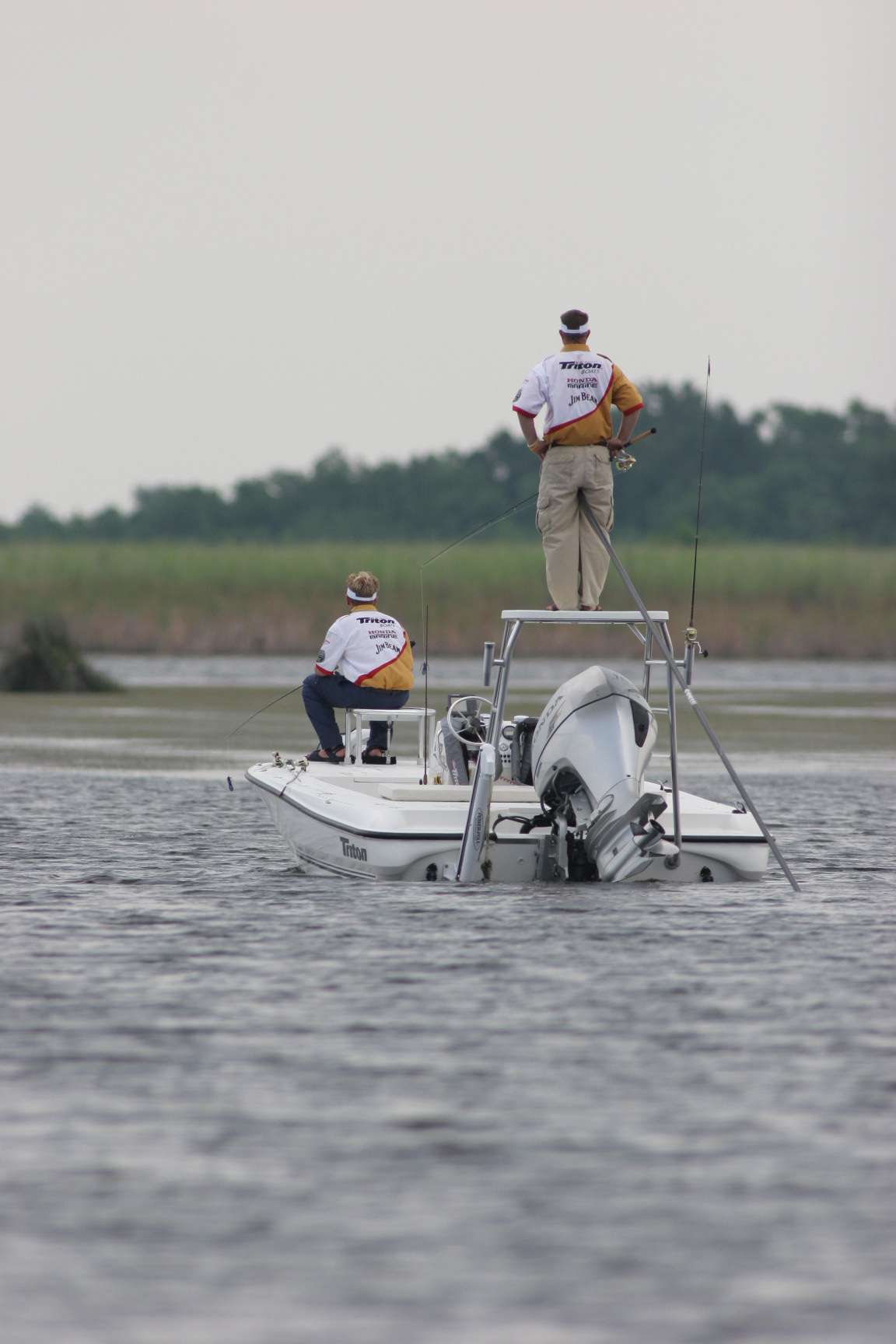
When professional redfish angler and guide Scott Guthrie fishes his home waters on the St. Johns River near Jacksonville, Fla., he looks like a fish genius. He knows, long before he gets to a particular fishing spot, how many redfish will be there and exactly where each individual fish will be positioned.
“He’s incredible,” admitted fellow redfish pro Terry Brantley, who has spent time with Guthrie on the St. Johns. “Just before you get to a spot, he’ll say, ‘There will be 5 redfish in here, two in the pocket to the left, two next to the sandbar and the biggest one will be all the way in the back.’ And sure enough, when you get in there and stand up on the platform, there they are, just like he called it.”
“Those fish are like his pets,” said Rick Murphy, Guthrie’s team partner in pro redfish tournaments. “It’s like he has them named. He knows what they’re doing before they do.”
Guthrie and Murphy won an FLW Redfish Series event in Jacksonville in March and Murphy got to witness Guthrie’s redfish prophecies unfold into fruition several times a day.
“Everywhere we went, he told me exactly how the fish would be set up and that’s exactly how they were,” Murphy said. “It’s awesome. He showed me a triplet of nice reds in a creek pocket on the first day and told me they’d be in the exact same spot the next day. When we came back the next afternoon, there they were, like they had been frozen in time.”
Guthrie’s uncanny ability does not come from black redfish magic or a direct line to the redfish gods, but rather from a decade of studying redfish in the St. Johns system. The most powerful discovery he has made is the degree to which redfish, specifically slot redfish, are residential creatures.
It’s a commonly accepted biological theorem that once a redfish becomes sexually mature at about 4 years of age (roughly anywhere from 27 to 32 inches), the fish’s instinct to migrate towards the deeper passes to be with the spawning stock kicks in. But up until that time, immature redfish (legal slot reds) just want to hang around the “house” and eat.
“We’ve always known that slot-size reds were more prone to stay in one general area than the bigger migrating reds,” Guthrie said. “But it was not until I started studying them in the tidal creeks of the St. Johns that I truly understood just how much of a homebody a redfish can be.”
The St. John’s tidal basin provides Guthrie a unique laboratory in which to study redfish. Unlike the open shallow flats and passes on the Gulf of Mexico, the St. Johns is more of a one-way in and one-way out system.
“Once a fingerling red finds its way into a tidal creek off the St. Johns or Intracoastal Waterway, that fish stays there,” Guthrie said. “And I believe it will live in that same 200-yard creek until it is caught and moved or until it becomes big enough to join the spawning reds in deeper water.”
At times, Guthrie has watched the same group of reds inhabit a creek for weeks and months at a time.
“They’re not big schools, just small packs of maybe 6 to 12 fish,” he said. “They do make daily movements with the tides. We have a 6-foot tide here in Jacksonville and when the tide comes in, they’ll move up into the flooded marsh grass and eat fiddler crabs. But when the tide drops out, they find their way back into the exact same tidal creek pool they were sitting in before the tide came in. It’s like clockwork and they do it day after day.”

Domestic Déjà vu
In August, Guthrie and Murphy won the Oh Boy! Oberto Redfish Cup presented by Frogg Toggs event out of Lake Charles, La. Although he was a long way from Jacksonville, Guthrie relied on his residential redfish knowledge from the St. Johns to help propel the team to victory.
“Obviously, the terrain is much different in Louisiana, but the circumstances were similar in terms of the fish being very residential,” he said.
In practice, Guthrie and Murphy had discovered a long, shallow ditch which terminated into a pond.
“The pond wasn’t on our maps and the ditch looked like it just fizzled out into the marsh,” Guthrie described. “I kept pushing to see where it ended up and the minute I saw the shallow ditch drop off into slightly deeper water, I got excited. When I reached the pond I immediately noticed clear water, hydrilla and bait popping everywhere. Once I observed a few upper-slot reds just sitting still in the grass, I knew I had found a home run.”
Home Inspection
Whether it’s tidal creeks in Jacksonville or ponds in Lake Charles, Guthrie emphasizes that he looks for a few common denominators when seeking residential reds.
First, he wants an area that is closed off by some kind of natural barrier.
“Tidal creeks in Jacksonville will often have shallow sandbars that close off the back ends and create small pools,” he said. “The fish could easily go over the bars and leave if they wanted, but I think the bars create a protective barrier that provides security.”
Similarly, ponds in Louisiana provide the same kind of security: a naturally enclosed system with one or two shallow pathways in and out.
Second, Guthrie examines water clarity and depth. Simply put, the clearer the water, the better.
“Targeting resident reds is usually a sight specific tactic,” he said. “I have seen occasions when resident reds in a closed bay or pond will get on things like stumps or docks and you have to blind-cast for them. But for the most part, it’s a sight-fishing situation, so clear shallow water is a premium.”
The third component is forage.
“The refrigerator must be full,” he said. “Whether it’s baitfish, shrimp or crabs – there must be plenty for the reds to eat.”
The final ingredient is good cover. In Jacksonville that usually consists of grass points or pockets, oyster bars or sand bars – anything that provides a tiny bottom contour change. In Lake Charles the primary cover was an abundance of hydrilla.
“I think of cover as rooms within the house,” Guthrie surmised. “Reds will pick one specific spot within a general area – usually around pronounced cover – to spend most of their time. The pond at Lake Charles was big, but the fish were using a small 40-yard area where the hydrilla was thickest.”

Reading the Residents
If the potential homestead has all the right ingredients, then Guthrie begins looking for fish. After years of observing redfish in Jacksonville, Guthrie has learned to identify resident reds by their demeanor and physical characteristics.
“If reds start bolting off and darting around in a mad panic, that’s a bad sign,” he said. “That usually means they are nervous and uncomfortable. However, if the reds sit still or mill around seemingly unalarmed, that’s a good sign. Those fish have been there for while; they are comfortable, and most importantly, they’re not going anywhere.”
Eventually, Guthrie will try to catch one or two fish to test their responsiveness to a lure and check their length, weight and color.
“Residential reds have a certain look,” Guthrie explained. “They’re usually fatter and have a deep copper color. Reds that are moving around a lot or migrating through an area trying to find better food tend to be longer and leaner. But a resident red that has been comfortably lounging around eating all day is going to be fatter for its size.”
House Arrest
Once Guthrie has his residential reds staked out and it’s time to make the bust, stealth becomes key. He and partner Rick Murphy sneak up on the quarry by being as discreet as possible.
“Silence is golden and we don’t froth the water with casts,” Guthrie remarked. “We take the time to pole in and stake down at the best angle and distance. In tournaments, the pay off for fishing this way is being able to choose which two redfish you want to catch. If there are six reds sitting in an area, you want to select to the two best ones (based on size) and make a precise cast to just those fish. Accidentally catching a smaller one can spook the others and ruin your chances at a bigger fish.
“For Rick and I, it’s absolutely awesome when a residential type game plan comes together like it did at Jacksonville and Lake Charles this year,” Guthrie added. “The thrill of discovering, analyzing and catching residential reds is the pinnacle of redfishing for us.”
